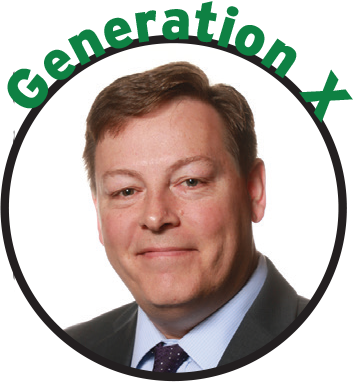
While 65 has long been considered the traditional retirement age, younger employees face the possibility of working longer. Plan sponsors can learn much from the unique financial journeys taken by different generations toward their eventual golden years.
A 2019 Scotiabank investment poll revealed that 68 per cent of Canadians are currently saving for retirement, but 70 per cent are worried they aren’t saving enough. It also found only 23 per cent of Canadians considered saving for retirement a top priority, while 66 per cent said they likely underestimated how much money they will need in retirement.
With working-age Canadians mainly distributed across four generational cohorts (baby boomers, generation-Xers, millennials and generation-Zers), the issue of retirement savings can elicit a wide variety of opinions.
Read: Young Canadians focusing on retirement, financial security amid coronavirus crisis: survey
As the prevalence of defined-benefit pension plans continues to shrink, millennials and gen-Zers have taken different approaches in saving towards their eventual retirement. And while many baby boomers and gen-Xers may have had a DB plan to help them save for their later years, Statistics Canada found in 2018 that 49 per cent of Canadians working past age 60 were doing so out of necessity. With the average monthly Canada Pension Plan payment hovering around a mere $679, the above statistic perhaps comes as no surprise.
Benefits Canada spoke with six employees from different life stages to compare how they prioritize their retirement savings and the various plans and methods they use to build a nest egg.

As long-time employees of Nortel Networks Corp., John and Kathy Drayton have partially retired with the assistance of a DB plan that was later transitioned to a defined contribution pension. However, the road to partial retirement has been bumpy.
Kathy, 59, was downsized from Nortel in 2000 after 20 years with the company, later joined Ottawa-based software firm Cognos Inc. and then a local doctor’s office. While she says Cognos (which was later acquired by IBM Corp.) had a good benefits package, including a DC pension, her current employer doesn’t offer any type of savings plan.
Read: Nortel pensioners lose $200M refund battle with Ontario’s PBGF
John, 63, also started with Nortel in 1980 and stayed on until its bankruptcy and subsequent purchase by Ciena Corp. in 2013, at which point his DB plan was transitioned to a DC model with an annual employer match of $1,800, he says.
Pensions by the numbers
4.2M
The number of Canadians enrolled in a DB pension plan as of 2017, compared to 1.16 million in a DC plan
$70B
The amount in dollars of total employer and employee contributions to registered pension plans in 2017
$1.9T
The market value of registered pension plans in Canada in 2017, 56.3 per cent of which was held by the 31 largest plans representing more than half of the total registered pension plan membership in Canada
Source: Statistics Canada
“The argument that Ciena would make is that they pay pretty well — and they did — but fundamentally, I had to look at taking somewhere in the neighbourhood of 18 to 20 per cent of my after-tax salary and bonuses [myself to save for retirement] and I made a conscious effort to put that in [tax-free savings accounts] and a personal [registered retirement savings plan]. You need the discipline to be able to do that and certainly the lump sum I got from Nortel made a significant difference.”
While he retired from Ciena in 2019, it took nearly eight years to be paid out from the Nortel portion of the pension due to complications arising from the bankruptcy, which the telecom filed for in 2009.
“In the end, the pensioners got around 88 per cent of what they were owed. We had a choice and I took mine as a lump sum, while others took it as an annuity. The pensioners that were already on an annuity just had their pension payments reduced.”
John says that while the DB payout has been instrumental in funding their retirement goals, the couple realizes younger workers face a different reality.
Read: Editorial: Helping turn retirement dreams into reality pays off
“My father worked at Ford and had a great benefits package, so I may have taken it for granted. We’ve got two kids in their twenties and it’s so much tougher for them to find any job that gives you that kind of pension plan. The benefits are all minimal or DC. The young folks entering the workforce will have a much tougher time saving for retirement than we did.”

With a career spent exclusively in the education sector, Jeff Barber of the Ontario Teachers’ Federation has been contributing to the Ontario Teachers’ Pension Plan for decades.
Currently serving as director of pensions and economic affairs for the federation, Barber, 51, previously worked as president of his local teachers’ union, during which time he assisted members in preparing for retirement. Starting his teaching career in Quebec, he also contributed to the Régime de retraite des employés du gouvernement et des organismes publics, later transferring his contributions to Ontario.
“I’ve learned I’m very fortunate to have a DB pension plan. When my first child was born and they tried to sell me a [registered education savings plan], I said I didn’t know if I could do that plus a [RRSP]. With the DB plan, we realized we may not need an RRSP so we shut it down at that time.”
Read: Canadians worrying about financial stress, job loss and retirement amid pandemic: survey
Retirement by the numbers
64.6
The overall median retirement age in Canada as of 2020
70
The likely retirement age for millennials, generation-Xers and some working baby boomers as of February 2020
62.4
The average age by which most public-sector employees retire, compared to 68 for freelancers and gig workers
$697,000
The amount in dollars that the average Canadian expected to need for retirement as of 2019
Sources: Mercer Canada, Statistics Canada, Scotiabank
For members under age 65, the Ontario Teachers’ DB plan is considered a two per cent pension, which multiplies two per cent by a member’s credited years by their best five years. While retirement at age 50 is possible, Barber plans to avoid the associated financial penalties by retiring sometime after his pension becomes unreduced according to the 85 factor, which considers a member’s age plus the number of qualifying years they have accumulated.
“There’s a lot of reasons why people continue working — some have a passion for education and don’t want to leave. But if the financial piece is looked after, that’s a major reason why many retire early.”
In addition to the pension, Barber and his wife have also started contributing to RRSPs again in recent years to prepare for their upcoming retirement.
“I had goals throughout my life, such as paying off my mortgage before my children entered post-secondary education so that I could focus the mortgage money to help support them. But I know not everyone has the luxury to do that.”

An employee of Natural Resources Canada, Abla Hanna has been a member of the Public Service Pension Plan since she started her career in the federal government 15 years ago.
It was shortly after joining Natural Resources that she began more seriously considering retirement savings. In addition to her pension coverage, Hanna, 40, also started making larger contributions to an RRSP, partly due to an increased amount of disposable income. “I was 26 when I joined the public service, so I was probably 30 when I started to put a bit of money into RRSPs. It was a combination of making more money but also prioritizing different things in life, and also knowing that if I put some money aside [in an RRSP], I’d get a tax return out of this.”
Read: Women retiring two years later, with 30 per cent less wealth, than men: report
While retirement isn’t on the immediate horizon, she says, after 30 years of service, the pension will provide 60 per cent of her salary based on the best five years and should she plan to work for 35 years, the coverage will increase to 70 per cent. “It’ll be the bulk of my retirement income with some RRSPs set aside to supplement it. I’m counting on it being quite sufficient.”
Looking ahead, Hanna says her goal is to align retirement with covering her daughter’s tuition costs and paying off her mortgage, the latter of which became more of a focus during the coronavirus pandemic.
“We have a bit more money now because we’re not able to travel, so that’s actually allowed me to put more money on my mortgage, which certainly helps. If my mortgage is paid off and I have income coming in [upon retirement], I’ll have won!”

As a full-time freelance photographer, Geoff Fitzgerald has had to look at retirement savings options beyond any form of employer pension.
“When I went to freelance, I hadn’t considered retirement at all. Retirement is a bigger priority now and it comes with the territory of getting older. We bought a house and are starting to settle down. When you’re 20, you’re thinking about now, not the future. But as you start to develop your working life, you start to think more long term.”
Setting aside between $300 and $500 each month for retirement, Fitzgerald, now in his late 30s, says a money coach has been instrumental in helping him and wife Vanessa align their accounts and make better financial plans for the future, as well as for their own mental health.
Read: Onus increasingly on employees to plan for retirement but employers still play role
“In order to not have this looming weight on your conscience, it helps to balance my money and say ‘I’ve got this much and I’m going to spend this much and put this much into [a RRSP].’ These are really important for young people moving into the new, post-pandemic world and if you’re not working a typical 9-to-5 job, it’s even more important to know where all of your finances are going and to ensure you continue to save.”

Working at a Toronto-based software startup, Geoff Seeman says his employer doesn’t currently offer any form of pension or group savings plan.
But that hasn’t stopped the 24-year-old from earmarking a portion of each paycheque for long-term savings. While Seeman isn’t saving for retirement with a specific amount in mind, he views any money he’s set aside as eventually going toward that goal — plus with the coronavirus pandemic saving has become easier as his expenses have shrunk, he notes.
“In the short term, I want to keep enough cash from paycheques to pay for rent, food and other necessities, but also take a decent chunk of each pay and invest it. I’m not saving the bare minimum to buy a house or fund vacations for the next 10 years. I live a fairly minimalist lifestyle, so aside from food and rent, I don’t spend money on too much else.”
Read: A quarter of Canadians unaware of difference between RRSPs, TFSAs: survey
Key takeaways
• Employers can engage their employees with savings plans that help them achieve their individual goal.
• With money management a key component of a successful retirement, there’s also an opportunity
for plan sponsors to engage staff by offering financial education programs as an employee benefit.
• As younger employees face a delayed retirement, employers should consider the impact of that extended working life on their business.
Without an employer-sponsored plan, he’s opted for a combination of a TFSA and direct investment via exchange-traded funds, mostly in technology stocks. It’s a strategy that’s so far paid off with 2020 returns in line, or slightly above, the S&P 500, Seeman says.
Investing has been a family activity for many years and was accelerated during his university years. “I studied business as an undergrad, so I was quite involved in that world, whether talking to friends in an investment club or discussing stocks and companies.”
Blake Wolfe is an associate editor at Benefits Canada.
